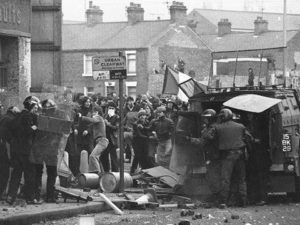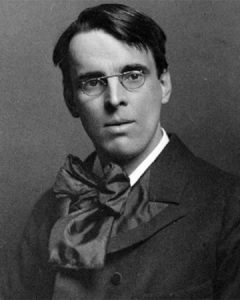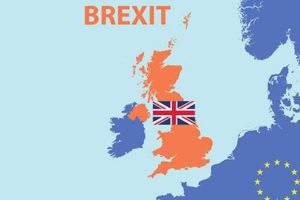Prosegue la collaborazione fra il Liceo Linguistico “Cattaneo-Dall’Aglio” e Redacon.
"Speakeasy", una rubrica curata dagli studenti.
Brexit and the Irish question

For two years we have all been hearing about Brexit. But why is it so important and why is it going to affect the whole world? Moreover, is it going to cause any problems? Before we start, we should know what we are speaking about. Brexit is an abbreviation for “British exit” and this term is used to refer to the United Kingdom's decision to leave the European Union. It follows the referendum of 23rd June 2016, when the majority of the British people voted to leave.
First of all, let’s explain what is going on: Britain is set to officially leave the European Union some time before the end of 2019. This means that England, Scotland, Wales and Northern Ireland will have to make big changes, such as new trade deals and new migration rights.
But out of all these problems, the most complicated is probably the one on the Irish border, which is holding up Brexit. In fact, we all know that the Republic of Ireland is not going to leave the EU, but it shares a border with Northern Ireland, which is part of Brexit, as we said before. This creates a big issue: how can they control the transition of goods crossing in and out of the EU? And what is going to happen on the Irish border?
People are trying to find a solution, but for the time being that seems impossible. Some of them think that the best and easiest way possible is to raise fences and checkpoints on the border, but that is the last thing most people want.
That’s because Northern Ireland has had fences and checkpoints on the border before, and in that case more than 3,600 people died in a conflict known as “The Troubles”, which lasted 30 years, from 1968 to 1998.
The violence was caused by the fact that, although the majority of Northern Ireland’s population was Protestant, there was a substantial minority of Catholics that wanted Northern Ireland to join the Republic.
After three decades of conflict, the Good Friday agreement put an end to the violence in 1998, but the impact of The Troubles can still be seen today, especially in Belfast, where there are walls separating Protestant and Catholic communities, and there is still occasional violence. Therefore, many people are scared Brexit might mean a return to conflict.

The uprising, called “Easter Rising”, was organised on 24th April 1916. An Irish Republic was proclaimed.
However, the insurrection was repressed by the British Army and the rebels were executed. In 1918 the Sinn Féin Party (a Gaelic name meaning ”ourselves alone”) won the election and established an Irish parliament, the Dáil, and the Irish Volunteers became the IRA (Irish Republican Army).
The rebellion inspired William Butler Yeats' poem “Easter 1916”.
Before talking about the poem, let's say something about the author. Yeats was born in Dublin and had Anglo-Irish origins. So he felt as much Irish as British.
Yeats’s poem is also known for its famous refrain “All changed, changed utterly: / A terrible beauty is born”. The poem was written to celebrate four of the leaders of the rising: Constance Markievicz, Patrick Pearse,Thomas MacDonagh and John Macbride, the husband of Maud Gonne, the woman Yeats loved his whole life. Apart from Constance, all the other leaders were executed after the insurrection.

The Poem “Easter 1916” is made up of 4 stanzas. The first and the third stanzas are divided in 16 lines, whereas the second and the fourth stanzas have 24 lines. If we pay attention we can see that there's a numerical symbology. For example the number of the stanzas is referred to the 4th month of the year, April, when the uprising took place; the 16 lines represent both the year 1916 and the 16 men who were executed after the Rising. Finally, the 24 lines represent the day of the rebellion.
It opens up with Yeats remembering the rebels returning from work as he walks on the streets in Dublin. Before the Rising they were just ordinary people, with whom he made superficial talks, saying “polite, meaningless words” and even making fun of them at the “club”. This proves that these rebels weren’t taken seriously by most of people, at least at first, until something changed, as Yeats says.
In the second stanza, in fact, the poet starts making serious considerations about them: he describes the rebels as people who had led to the birth of a “terrible beauty“.
In the third stanza the author talks about these people who have just one purpose and whose hearts have turned to stones.
Because of their determination and persistence they have troubled the living stream of everybody's life. The stone is a metaphor for their ideal and it becomes a hurdle for everyone and even for the nature. It's like a stone in the stream that impedes the flowing water.
In the final stanza Yeats is wondering whether this sacrifice of the martyrs was necessary and enough. So we can understand that the poet has mixed and ambivalent feelings and attitude towards the revolutionaries and Irish Nationalism. Then he starts seeing that the rebels’ death had brought a change to the feelings of many Irish people who were against the insurrection. It had made them more aware about the independence issue.
For this reason we find in the stanzas the famous refrain “A terrible beauty is born”, meaning that the Easter Rising was terrible because of the violence and the executions of many people, but this gave birth to a beauty: the desire of a Free State.
(Chayma El Hana, Francesca Loprete)
Traduzione
Da ormai due anni abbiamo tutti sentito parlare della Brexit. Ma perchè è così importante parlarne e perché si dice che avrà un impatto su tutto il mondo? Inoltre, causerà dei problemi?
Prima di cominciare, bisogna sapere di cosa si sta parlando. La parola “Brexit” è l’abbreviazione di “British exit”, cioè “l’uscita britannica” e questo termine viene usato per indicare la decisione del Regno Unito di lasciare l’Unione Europea, in seguito al referendum del 23 giugno 2016, quando la maggioranza della popolazione ha detto sì alla Brexit.
Per prima cosa, spieghiamo cosa sta per succedere: la Gran Bretagna lascerà ufficialmente l’UE il 29 marzo 2019. Ciò significa che Inghilterra, Scozia, Galles e Irlanda del Nord dovranno affrontare grandi cambiamenti, come nuovi accordi commerciali e nuove politiche sui diritti dei migranti. Ma tra tutti questi problemi, il più complicato e quello che sta rallentando la Brexit è probabilmente quello che riguarda il confine irlandese.
Infatti, sappiamo tutti che la Repubblica dell’Irlanda non lascerà l’UE, però confina con l’Irlanda del Nord, che, come detto prima, fa parte della Brexit. Ciò crea un grande problema: come si farà a controllare il trasporto di merci da un paese all’altro? E cosa accadrà proprio su quel confine?
In molti stanno cercando di trovare una soluzione, ma per il momento sembra impossibile. Alcuni pensano che la strada migliore e più semplice sia costruire delle recinzioni e dei posti di blocco sul confine, ma questa è l’ultima cosa che la maggior parte delle persone vorrebbe. Ciò è dovuto dal fatto che l’Irlanda del Nord ha già avuto delle recinzioni sul suo confine in passato, e in quel caso più di 3.600 persone morirono in un conflitto conosciuto come “The Troubles”, termine traducibile con “i disordini”, che durò per 30 anni, dal 1968 al 1998.
La violenza di questo conflitto è stata causata dal fatto che, nonostante la maggior parte dei nordirlandesi fosse protestante, era presente una solida minoranza di cattolici che voleva che l’Irlanda del Nord si unisse alla Repubblica d’Irlanda. Dopo 3 decenni di scontri, l’Accordo del Venerdì Santo mise fine alla violenza nel 1998, ma il suo impatto è ancora visibile oggi, specialmente a Belfast, dove ci sono dei muri che separano le comunità cattoliche da quelle protestanti, ed occasionalmente ci sono ancora scontri. Perciò, molte persone temono che questo tipo di situazione possa persino peggiorare dopo la Brexit.
Tuttavia, se vogliamo trovare una soluzione, dobbiamo capire la situazione dell’Irlanda nel corso degli anni. L’intera isola è stata sotto il dominio britannico sin dal Medioevo, ma nel ventesimo secolo ci fu una svolta. Al tempo i nazionalisti irlandesi volevano una nazione indipendente con il proprio parlamento a Dublino, mentre gli unionisti, per lo più presenti nelle contee protestanti dell’Ulster, volevano rimanere parte del Regno Unito. Da questo disaccordo nasce la cosiddetta “Questione Irlandese”. In seguito, all’Irlanda fu promesso un decreto, chiamato Home Rule, che le garantiva una forma di indipendenza. Purtroppo, la messa a punto dell’Home Rule Bill, approvato dal parlamento di Westminster, fu sospesa a causa della prima guerra mondiale.
Tuttavia, questo decreto non soddisfò gli irlandesi. Nel 1916, mentre l’Inghilterra era impegnata nella prima guerra mondiale, un gruppo di nazionalisti colse l’opportunità per ribellarsi all’impero britannico. Questa rivolta, chiamata Easter Rising (“rivolta di Pasqua”) venne organizzata il 24 aprile 1916, quando una repubblica irlandese fu proclamata. L’insurrezione fu però fermata dall’esercito inglese e i ribelli furono giustiziati.
In 1918 il partito chiamato Sinn Féin (un nome gaelico che significa “noi soli”) vinse le elezioni e istituì un parlamento irlandese, il Dáil, e i Volontari irlandesi divennero l'IRA (Esercito Repubblicano Irlandese).
La ribellione ispirò il poema “Pasqua 1916” di William Butler Yeats. Prima di parlare del poema, diciamo qualcosa dell'autore. Yeats nacque a Dublino e possedeva origini anglo-irlandesi. Perciò si sentiva tanto irlandese quanto britannico.
Il poema di Yeats è anche noto per il suo famoso ritornello "Tutto è cambiato, completamente cambiato: / È nata una terribile bellezza". Il poema è stato scritto per celebrare 4 dei leader della rivolta: Constance Markievicz, Patrick Pearse,Thomas MacDonagh e John Macbride, marito di Maud Gonne, la donna che Yeats aveva amato per l'intera sua vita. Tranne Constance, tutti i leaders sono stati giustiziati, dopo l'insurrezione.
Il poema "Pasqua 1916" è composto da 4 strofe. La prima e la terza strofa sono formate da 16 versi, mentre la seconda e la quarta hanno 24 versi.
Se prestiamo attenzione, possiamo vedere che c'è una simbologia numerica. Ad esempio, il numero delle stanze è riferito al 4° mese dell'anno, aprile, quando è avvenuta la rivolta; i 16 versi rappresentano sia l'anno 1916 che i 16 uomini che furono giustiziati dopo la Rivolta. Infine i 24 versi rappresentano il giorno della ribellione.
Il poema si apre con Yeats che ricorda i ribelli che tornavano dal lavoro, mentre cammina per le strade di Dublino. Prima della Rising essi erano solo persone comuni, con le quali egli discuteva superficialmente, dicendo "parole educate e senza senso" e persino prendendole in giro al "club".
Ciò dimostra che questi ribelli non erano presi sul serio dalla maggior parte delle persone, almeno all'inizio, finché qualcosa non cambiò, come dice Yeats. Nella seconda strofa, infatti, il poeta inizia a fare considerazioni serie su di loro: descrive i ribelli come persone che hanno portato alla nascita di una "terribile bellezza".
Nella terza strofa l'autore parla di queste persone che hanno un solo scopo e i cui cuori si sono trasformati in pietre. A causa della loro determinazione e perseveranza esse hanno turbato il flusso vitale della vita di tutti. La pietra è una metafora del loro ideale e diventa un ostacolo per tutti e anche per la natura. È come una pietra nel flusso che impedisce lo scorrere dell'acqua.
Nell'ultima strofa Yeats si chiede se questo sacrificio dei martiri sia stato necessario e sufficiente. Quindi possiamo capire che il poeta ha sentimenti e atteggiamenti contrastanti e ambivalenti nei confronti dei rivoluzionari e del nazionalismo irlandese. In seguito, inizia a vedere che la morte dei ribelli aveva portato un cambiamento nei sentimenti di molti irlandesi che erano contro l’insurrezione. Li ha infatti resi più consapevoli sul problema dell’indipendenza in Irlanda.
Per questa ragione troviamo nelle strofe il famoso ritornello: ”A terrible beauty is born”, nel senso che la “Rivolta di Pasqua” è stata terribile a causa della violenza e delle esecuzioni di molte persone, ma allo stesso tempo ha portato alla nascita di una “bellezza”: il desiderio di uno Stato Libero.
(Chayma El Hana, Francesca Loprete)









Si parla tanto di referendum 2016 e della volontà espressa dal popolo.
Ma l’esito del 2016 diede altri risultati
37% per uscire da UE
35% per restare in UE
28% non votarono
100% … gli aventi diritto.
Anche in assemblee condominiali le decisioni più importanti devono essere approvate da 501 millesimi … non dalla maggioranza dei votanti.
Anche il referendum per il passaggio della provincia italiana del VCO (Verbania Cusio Ossola) del 2018 dal Piemonte alla Lombardia fu soggetto ad una doppia maggioranza riferita sempre agli aventi diritto (50%+1 degli aventi diritto al voto).
In precedenza altri comuni passarono all’Emilia Romagna ma con votazione plebiscitaria.
Il referendum 2016 stabilì esclusivamente che il 52% dei soli votanti si espresse a favore dell’uscita da EU. Quasi esclusivamente per divergenze di opinione sulla politica di immigrazione europea attuata in quel periodo.
Oggi quel 37% probabilmente si assesterebbe ad un 27%.
Lui la plume